 Meredith and I often laugh about “History Happened Here” signs, since they often seem to talk about something minor happening in the area back in 1910. It usually doesn’t conjure images of long history. Colonial Williamsburg is a different matter – many of the buildings date back to the mid-1700s, and the actors wandering the streets portray Washington, Lafayette, Patrick Henry, and other famous folks, as well as more humble tradespeople.
Meredith and I often laugh about “History Happened Here” signs, since they often seem to talk about something minor happening in the area back in 1910. It usually doesn’t conjure images of long history. Colonial Williamsburg is a different matter – many of the buildings date back to the mid-1700s, and the actors wandering the streets portray Washington, Lafayette, Patrick Henry, and other famous folks, as well as more humble tradespeople.
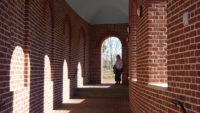 Sunday night, I was agonizing over if we should spend one day or two touring the historical town. I looked online, and everyone seemed to say two days, so I planned on that. Of course, I got it wrong; we need three. And that is in the many-buildings-closed Covid era. Meredith and I are a bit…thorough.
Sunday night, I was agonizing over if we should spend one day or two touring the historical town. I looked online, and everyone seemed to say two days, so I planned on that. Of course, I got it wrong; we need three. And that is in the many-buildings-closed Covid era. Meredith and I are a bit…thorough.
Williamsburg is mainly along two streets. We didn’t plan it this way, but it worked out so that we did the longer street on Monday, and the shorter street (almost) today. I have to say almost, because there are still two buildings we didn’t get into because the lines were long. We’ll beeline to those tomorrow before the crowds hit, and cross those off the list.
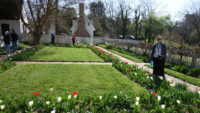 Happily, we went into the ticket office in the not-yet-seen art museum, and my plan was to buy a three-day pass (there are no two-day passes). The cashier asked if we were teachers, and since we are, we ended up with two year-long passes for just twelve dollars (total) more than two three-day passes. So, if we need to spill into a fourth day, we are covered. And we can still come back in the summer or next fall or have Christmas in Williamsburg. Options abound.
Happily, we went into the ticket office in the not-yet-seen art museum, and my plan was to buy a three-day pass (there are no two-day passes). The cashier asked if we were teachers, and since we are, we ended up with two year-long passes for just twelve dollars (total) more than two three-day passes. So, if we need to spill into a fourth day, we are covered. And we can still come back in the summer or next fall or have Christmas in Williamsburg. Options abound.
We chatted with several actors/docents who were in period costume. Good effort is made to make things appear as authentic as we know how. Costumes are made by hand, using textiles and techniques used in the eighteenth century. All the carts and harnesses are made by the craftsmen in the town, and when they have the opportunity to reconstruct or repair a building, the on-site carpenters and brick makers are involved in that. Some things are updated, since people live in the area – most of the updates aren’t overly visible (outside of cash registers), but the buildings have electricity and plumbing, and the main road is paved. Since the original road was reported to have been covered in mud as deep as six feet at times, I’m okay with the updates that help us enjoy the museum.
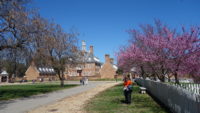 There are eighty-eight original buildings in the town (ones dating back to 1776 or so), and many others that have been recreated from original town records and archeological efforts. The long street is about one mile long. There is much to see. Rather than recount everything we saw, I’ll mention a few things that stood out.
There are eighty-eight original buildings in the town (ones dating back to 1776 or so), and many others that have been recreated from original town records and archeological efforts. The long street is about one mile long. There is much to see. Rather than recount everything we saw, I’ll mention a few things that stood out.
The two most impressive buildings are on opposite ends of the town – the capitol building, where all three branches of government met, and the governor’s palace. Both are made of a pretty red brick. The county court (for non-felony cases) was also elegant, and the magazine (armory) was impressively stout in brick. Most buildings were made of wood, and many were small by today’s standards. For the craftsmen, they typically had a shop on the first floor and lived above it on the second floor.
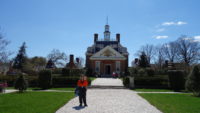 Some fun facts we learned over two days, in no particular order:
Some fun facts we learned over two days, in no particular order:
– After independence was declared, many raw goods were hard to procure. There are records of skilled workers idle for want of material.
– Orphaned girls could be taken in and apprenticed to silversmiths and blacksmiths.
– 52% of the population of the town were slaves.
– The town had dealings with multiple native tribes, which were treated as independent nations from each other.
– Tribal membership was not strictly based on bloodlines, but captured people could be adopted into the tribe and became full members of the adopting family.
– The waterways around the area are tidal, and so did not work well for water-wheel-run mills. Sawing logs was done with two-man saws, with one man standing in a pit and the other standing on top of the log.
– The town had fourteen taverns (in a town of eighteen hundred people). This was because the government and courts met in town several times per year. When the government moved to Richmond later, twelve of the taverns followed it.
– Enslaved people typically slept in the same room where they worked. Only a couple of the biggest and richest places in town had quarters for the slaves.
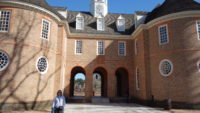 – Tailors measured men’s bodies to make clothes, but for dresses, the cloth was pinned up on the women and then sewn.
– Tailors measured men’s bodies to make clothes, but for dresses, the cloth was pinned up on the women and then sewn.
– County judges (thirteen of them) worked for no pay – it was a status symbol.
– Lafayette paid his own way over here to help in the revolution, and paid for his own upkeep. He was made a major general at the age of nineteen.
– A hogshead barrel of tobacco weighed a thousand pounds, and brought in enough money to buy six and a half more acres. When tobacco prices plummeted, the farmers tried growing indigo instead, which was in fashion.
– The governor of the free state of Virginia (Patrick Henry was the first) had to supply all costs of his entertaining guests out of his own salary.
We had a good time talking with people, and we saw three one-man shows – two by Native Americans and one by “Lafayette” – that were well done, and the closest thing to theater we have seen in awhile.
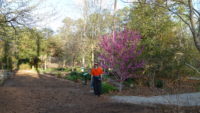 After the second day in Williamsburg, we made a quick trip out to Freedom Park, home of the small but free Williamsburg Botanical Garden. The park looked huge, but we had run out of touring time for the day. Next time.
After the second day in Williamsburg, we made a quick trip out to Freedom Park, home of the small but free Williamsburg Botanical Garden. The park looked huge, but we had run out of touring time for the day. Next time.
We have really enjoyed Colonial Williamsburg, and history really did happen here. Good thing we have another day (and maybe more) to see more of it!